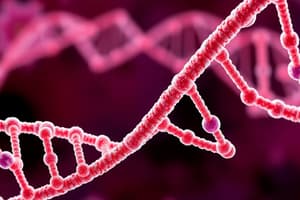Podcast
Questions and Answers
What does semi-conservative replication ensure?
What does semi-conservative replication ensure?
- Each new DNA molecule contains one original and one new strand. (correct)
- Genetic information is passed without any alterations.
- Each new DNA molecule contains only newly synthesized strands.
- DNA replication occurs without the need for enzymes.
What is the primary role of DNA helicase in DNA replication?
What is the primary role of DNA helicase in DNA replication?
- Stabilizes unwound DNA strands.
- Joins Okazaki fragments together.
- Unwinds the DNA double helix. (correct)
- Adds nucleotides to the growing DNA strand.
Which enzyme is responsible for synthesizing RNA primers during DNA replication?
Which enzyme is responsible for synthesizing RNA primers during DNA replication?
- Primase (correct)
- DNA Ligase
- DNA Polymerase III
- DNA Topoisomerase
What occurs during the synthesis of the lagging strand?
What occurs during the synthesis of the lagging strand?
How does DNA polymerase assist in maintaining the integrity of DNA during replication?
How does DNA polymerase assist in maintaining the integrity of DNA during replication?
What is the function of DNA ligase in the replication process?
What is the function of DNA ligase in the replication process?
What is the role of single-strand binding proteins (SSBs) during DNA replication?
What is the role of single-strand binding proteins (SSBs) during DNA replication?
What defines the replication fork in DNA replication?
What defines the replication fork in DNA replication?
Flashcards
DNA Replication
DNA Replication
The process of creating two identical DNA molecules from one original DNA molecule. It's essential for cell growth, repair, and reproduction.
Semi-Conservative Replication
Semi-Conservative Replication
Each new DNA molecule is made of one original strand (parent) and one new strand (daughter), ensuring accurate genetic inheritance.
DNA Helicase
DNA Helicase
An enzyme that unwinds the DNA double helix by breaking hydrogen bonds between base pairs, opening the helix.
Single-strand Binding Proteins (SSBs)
Single-strand Binding Proteins (SSBs)
Signup and view all the flashcards
DNA Topoisomerase
DNA Topoisomerase
Signup and view all the flashcards
Primase
Primase
Signup and view all the flashcards
DNA Polymerase III
DNA Polymerase III
Signup and view all the flashcards
Replication Fork
Replication Fork
Signup and view all the flashcards
Study Notes
Overview of DNA Replication
- DNA replication is the biological process of producing two identical replicas of a DNA molecule from a single original DNA molecule.
- This process is essential for cell growth, repair, and reproduction in all living organisms.
- It's a highly accurate and complex process, involving several enzymes and proteins.
- The process begins at specific sites known as origins of replication.
Semi-Conservative Replication
- The DNA replication process is semi-conservative, meaning that each new DNA molecule consists of one original strand (parent strand) and one newly synthesized strand (daughter strand).
- This ensures that the genetic information is faithfully passed from one generation to the next.
Key Enzymes and Proteins
- DNA Helicase: Unwinds the DNA double helix by breaking the hydrogen bonds between the base pairs.
- Single-strand Binding Proteins (SSBs): Stabilize the unwound DNA strands, preventing them from re-annealing (re-pairing).
- DNA Topoisomerase: Relieves the torsional strain ahead of the replication fork caused by unwinding. It does this by making temporary cuts in the DNA backbone.
- Primase: Synthesizes short RNA primers that provide a 3' hydroxyl group for DNA polymerase to start adding nucleotides.
- DNA Polymerase III: The main enzyme responsible for synthesizing new DNA strands by adding nucleotides to the 3' end of the RNA primer. It can only add nucleotides in the 5' to 3' direction.
- DNA Polymerase I: Removes the RNA primers and replaces them with DNA nucleotides.
- DNA Ligase: Joins the Okazaki fragments (short fragments of DNA synthesized on the lagging strand) together.
Leading and Lagging Strands
- DNA replication occurs in a bidirectional manner – two replication forks are formed at an origin point.
- On the leading strand, DNA synthesis is continuous in the 5' to 3' direction as the replication fork opens.
- The lagging strand's synthesis is discontinuous, producing short fragments (Okazaki fragments) that are later joined by DNA ligase.
Replication Fork
- The replication fork is a Y-shaped region where the DNA double helix is unwound during replication.
- Replication proceeds in both directions away from the origin of replication.
Proofreading and Repair
- DNA polymerase has proofreading activity, correcting errors immediately during replication.
- Specialized repair mechanisms fix any remaining errors after replication.
- These mechanisms help maintain the accuracy of the genome.
Telomeres and Replication
- Telomeres are protective caps at the ends of linear chromosomes.
- The replication of linear DNA presents a problem at the ends because DNA polymerase can only add nucleotides in the 5' to 3' direction.
- Telomerase is an enzyme that can replicate the ends of telomeres, thus preventing shortening of chromosomes with each round of replication.
Implications of DNA Replication Errors
- Errors in DNA replication can lead to mutations, which may have no effect or may produce a variety of deleterious effects, including developmental defects and cancers.
Studying That Suits You
Use AI to generate personalized quizzes and flashcards to suit your learning preferences.




